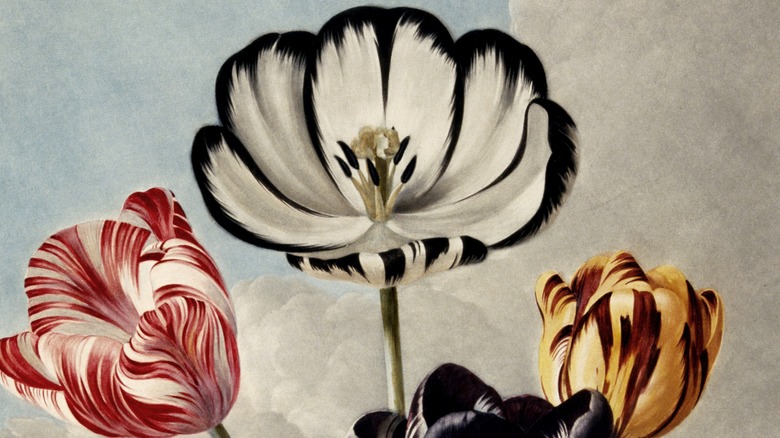The 17th-Century Tulip Mania Financial Crash Explained
According to Britannica, tulips arrived in Europe in 1550. However, Smithsonian Magazine writes that their origins lie in the surrounding area of the Tien Shan Mountains (also via Britannica) in Central Asia. As trading with the Ottomans and the east increased, Barron's reports that tulips found themselves in France before heading to Holland. Prior to their European introduction, tulips were an important aspect of culture in the Ottoman Empire. But their emergence into Dutch homes spurred something now known as tulip mania. The BBC reports that botanist Carolus Clusius contributed to this frenzy. He grew the flowers and was particularly fond of a certain tulip known as "broken bulbs."
Per Smithsonian Magazine, these tulips, which were usually a solid color, were striped and multi-colored. As The Conversation explains, tulip mania threw the Netherlands into chaos. Tulips were sold for a fortune, they were stolen (via the BBC), and most importantly, they were adored. Prices rose to an unfathomable rate. Anna Pavord, author of "The Tulip," wrote that the flower was "the ultimate status symbol, the definitive emblem of how much you were worth" (per the BBC). Like all fads, the popularity of tulips eventually decreased. Although tulip mania faded away, it left behind a legacy that is still speculated upon today.
Tulip Mania was short-lived
According to History, tulip mania became common knowledge in 1841 when writer Charles MacKay published his book "Memoirs of Extraordinary Popular Delusions and the Madness of Crowds." MacKay, in fact, is credited for referring to this time in 17th century Holland as "The Tulipomania." Anne Goldgar, an expert on this topic, told Smithsonian Magazine why she thinks tulip mania and the book became incredibly popular. She explained "People are so interested in this incident because they think they can draw lessons from it. I don't think that's necessarily the case." The BBC explains that tulips became not only an object of beauty but an investment.
A different article from the BBC states that in 1623, one individual offered 12,000 guilders for 10 rare tulips known as Semper Augustus. That was then the same price as a home in Amsterdam. Per The Conversation, some bulbs were sold and traded up to 10 different times in one day. Britannica writes that things came to a head in 1633. That's when the frenzy increased and everyone from Holland's upper class to the poor entered the tulip market. It's been reported that tulips were even used as currency. However, tulip mania ended in February 1637. The market crashed, leaving the Dutch economy in disarray.
With this market bubble burst, MacKay wrote, "Substantial merchants were reduced almost to beggary, and many a representative of a noble line saw the fortunes of his house ruined beyond redemption" (via History). That's how the story goes anyway, but the truth of the situation is much simpler.
There was little economic fall-out
The Conversation adds that some individuals killed themselves when they realized that they were bankrupt. However, Smithsonian Magazine reports that this is a dramatized version of what really occurred. The BBC writes that tulip mania ended simply because their demand decreased. Another article from the BBC states that the tulip trade was based on a guarantee that buyers would purchase the flowers in the future. Problems arose when they lacked the funds and the growers did not have not the tulips.
Although this caused the market to crash, it did not destroy the Dutch economy (per Smithsonian Magazine). Furthermore, no one truly suffered from the demise of tulip mania, per The Conversation. In reality, no one went bankrupt or killed themselves because of it. In an article in Barron's, Goldgar explained, "There are people who lose money, but we're talking about a small group of people and most of them who have enough money that it doesn't really make that much difference."
She went on to say that the Dutch economy was "completely unaffected by tulipmania" (via Barron's). Nevertheless, it did have social repercussions. According to The Conversation, sellers primarily sold to people they knew. When buyers, who had promised to purchase the tulips, refused to pay, this destroyed the "trust" in established relationships (per Smithsonian Magazine). As to why the tulip mania myth has endured, Goldgar states, "It's a great story and the reason why it's a great story is that it makes people look stupid" (via History).


